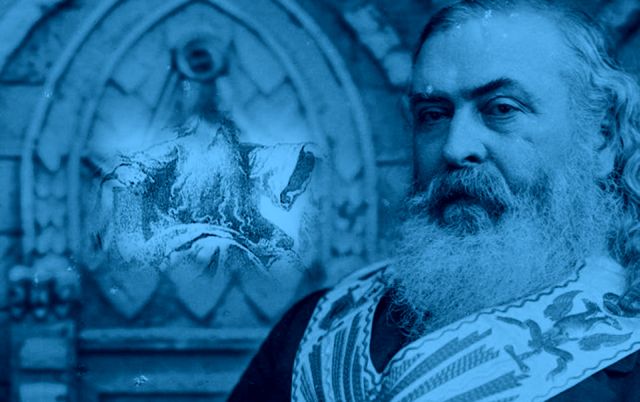(Source: Stanford University) – King wrote this paper for the course Development of Christian Ideas, taught by Davis. The essay  examines how Christianity developed as a distinct religion with a set of central tenets and how it was influenced by those pagan religions it assimilated. King repeats material from an earlier paper, “A Study of Mithraism,” but he extends the discussion here to the influence of other mystery religions.1
examines how Christianity developed as a distinct religion with a set of central tenets and how it was influenced by those pagan religions it assimilated. King repeats material from an earlier paper, “A Study of Mithraism,” but he extends the discussion here to the influence of other mystery religions.1
Davis gave the essay an A, stating: “This is very good and I am glad to have your conclusion. It is not so much that Christianity was influenced by the Mystery Cults, or borrowed from them, but that in the long process of history this religion developed. It, Christianity, is the expression of the longing of people for light, truth, salvation, security.
“That is, with this study you have made, we see the philosophy both of Religion and History. Underneath all expression, whether words, creeds, cults, ceremonies is the spiritual order–the [ever] living search of men for higher life–a fuller life, more abundant, satisfying life.
“That is essential. Never stop with the external, which may seem like borrowing, but recognize there is the perennial struggle for truth, fuller life itself. So through experience, knowledge, as through other forms, the outer manifestations of religion change. The inner spiritual, continues ever.”
The Greco-Roman world in which the early church developed was one of diverse religions. The conditions of that era made it possible for these religions to sweep like a tidal wave over the ancient world. The people of that age were eager and zealous in their search for religious experience. The existence of this atmosphere was vitally important in the development and eventual triumph of Christianity.
These many religions, known as Mystery-Religions, were not alike in every respect: to draw this conclusion would lead to a gratuitous and erroneous supposition. They covered an enormous range, and manifested a great diversity in character and outlook, “from Orphism to Gnosticism, from the orgies of the Cabira to the fervours of the Hermetic contemplative.”\[Footnote:] Angus, The Mystery Religions and Christianity, p. vii.\2 However it is to be noticed that these Mysteries possessed many fundamental likenesses; (1) All held that the initiate shared in symbolic (sacramental) fashion the experiences of the god. (2) All had secret rites for the initiated. (3) All offered mystical cleansing from sin. (4) All promised a happy future life for the faithful.\[Footnote:] Enslin, Christian Beginnings, pp. 187, 188.\
It is not at all surprising in view of the wide and growing influence of these religions that when the disciples in Antioch and elsewhere preached a crucified and risen Jesus they should be regarded as the heralds of another mystery religion, and that Jesus himself should be taken for the divine Lord of the cult through whose death and resurrection salvation was to be had.3 That there were striking similarities between the developing church and these religions cannot be denied. Even Christian apologist had to admit that fact.
Christianity triumphed over these mystery religions after long conflict. This triumph may be attributed in part to the fact that Christianity took from its opponents their own weapons, and used them: the better elements of the mystery religions were transferred to the new religion. “As the religious history of the empire is studied more closely,” writes Cumont, “the triumph of the church will, in our opinion, appear more and more as the culmination of a long evolution of beliefs. We can understand the Christianity of the fifth century with its greatness and weakness, its spiritual exaltation and its puerile superstitions, if we know the moral antecedents of the world in which it developed.”\[Footnote:] Cumont, Oriental Religions in Roman Paganism, p. xxiv.\4
The victory of Christianity in the Roman empire is another example of that universal historical law, viz., that that culture which conquers is in turn conquered. This universal law is expecially true of religion. It is inevitable when a new religion comes to exist side by side with a group of religions, from which it is continually detaching members, introducing them into its own midst with the practices of their original religions impressed upon their minds, that this new religion should tend to assimilate with the assimilation of their members, some of the elements of these existing religions. “The more crusading a religion is, the more it absorbs.” Certainly Christianity has been a crusading religion from the beginning. It is because of this crusading spirit and its superb power of adaptability that Christianity ahs{has} been able to survive.
It is at this point that we are able to see why knowledge of the Mystery religions is important for any serious study of the history of Christianity. It is well-nigh impossible to grasp Christianity through and through without knowledge of these cults.5 It must be remembered, as implied above, that Christianity was not a sudden and miraculous transformation, springing, forth full grown as Athene sprang from the head of Zeus, but it is a composite of slow and laborious growth.
Therefore it is necessary to study the historical and social factors that contributed to the growth of Christianity. In speaking of the indispensability of knowledge of these cults as requisite for any serious study of Christianity, Dr. Angus says: “As an important background to early Christianity and as the chief medium of sacramentarianism to the West they cannot be neglected; for to fail to recognize the moral and spiritual values of Hellenistic-Oriental paganism is to misunderstand the early Christian centuries and to do injustice to the victory of Christianity. Moreover, much from the Mysteries has persisted in various modern phases of thought and practice.”\[Footnote:] Angus, The Mystery Religions and Christianity, p. viii.\
This is not to say that the early Christians sat down and copied these views verbatim. But after being in contact with these surrounding religions and hearing certain doctrines expressed, it was only natural for some of these views to become a part of their subconscious minds. When they sat down to write they were expressing consciously that which had dwelled in their subconscious minds. It is also significant to know that Roman tolerance had favoured this great syncretism of religious ideas. Borrowing was not only natural but inevitable.6
The present study represents an attempt to provide a survey of the influence of the mystery religions on Christianity. In order to give a comprehensive picture of this subject, I will discuss Four {Five} of the most popular of these religions separately, rather than to view them en masse as a single great religious system. The latter method is apt to neglect the distinctive contribution of each cult to the religious life of the age and, at the same time, to attribute to a given cult phases of some other system. However, in the conclusion I will attempt to give those fundamental aspects, characteristic of all the cults, that greatly influenced Christianity.
The Influence Of The Cult Of Cybele and Attis
The first Oriental religion to invade the west was the cult of the Great Mother of the Gods. The divine personage in whom this cult centered was the Magna Mater Deum who was conceived as the source of all life as well as the personification of all the powers of nature.\[Footnote:] Willoughby, Pagan Regeneration, p. 114.\7 She was the “Great Mother” not only “of all the gods,” but of all men” as well.8 “The winds, the sea, the earth, and the snowy seat of Olympus are hers, and when from her mountains she ascends into the great heavens, the son of Cronus himself gives way before her, and in like manner do also the other immortal blest honor the dread goddess.”\[Footnote:] Quoted in Willoughby’s, Pagan Regeneration, p. 115.\9
At an early date there was associated with Cybele, the Great Mother, a hero-divinity called Attic who personified the life of the vegetable world particularly. Around these two divinities there grew up a “confused tangle of myths” in explanation of their cult rites. Various writers gave different Versions of the Cybele-Attis myth. However these specific differences need not concern us, for the most significant aspects are common in all the various versions.10 We are concerned at this point with showing how this religion influenced the thought of early Christians.
Attis was the Good Shepard, the son of Cybele, the Great Mother, who gave birth to him without union with mortal man, as in the story of the virgin Mary.11 According to the myth, Attis died, either slain by another or by his own hand. At the death of Attis, Cybele mourned vehemently until he arose to life again in the springtime. The central theme of the myth was the triumph of Attis over death, and the participant in the rites of the cult undoubtedly believed that his attachment to the victorious deity would insure a similar triumph in his life.
It is evident that in Rome there was a festival celebrating the death and resurrection of Attis. This celebration was held annually from March 22nd to 25th.\[Footnote:] Frazer, Adonis, Attis, Osiris, p. 166.\ The influence of this religion on Christianity is shown by the fact that in Phrygia, Gaul, Italy, and other countries where Attis-worship was powerful, the Christians adapted the actual date, March 25th, as the anniversary of our Lord’s passion.\[Footnote:] Ibid, p. 199\12
Again we may notice that at this same Attis festival on March 22nd, an effigy of the god was fastened to the trunk of a pine tree, Attis thus being “slain and hanged on a tree.” This effigy was later buried in a tomb. On March 24th, known as the Day of Blood, the High Priest, impersonating Attic, drew blood from him arm and offered it up in place of the blood of a human sacrifice, thus, as it were, sacrificing himself. It is this fact that immediately brings to mind the words in the Epistle to the Hebrews: “But Christ being come an High Priest . . . neither by the blood of goats and calves, but by his own blood . . . obtained eternal redemption for us.”\[Footnote:] Heb. 9:11, 12.\ Now to get back to the festival. That night the priests went back to the tomb and found it empty, the god having risen on the third day from the dead; and on the 25th the resurrection was celebrated with great rejoicing. During this great celebration a sacramental meal of some kind was taken, and initiates were baptised with blood, whereby their sins were washed away and they were said to be “born again.”\[Footnote:] Weigall, The Paganism In Our Christianity, pp. 116, 117.\13
There can hardly be any doubt of the fact that these ceremonies and beliefs strongly coloured the interpretation placed by the first Christians upon the life and death of the historic Jesus.14 Moreover, “the merging of the worship of Attis into that of Jesus was effected without interruption, for these pagan ceremonies were enacted in a sanctuary on the Vatican Hill, which was afterwards taken over by the Christians, and the mother church of St. Peter now stands upon the very spot.”\[Footnote:] Ibid, p. 117.
Read more from Stanford University

Moe is the founder of GnosticWarrior.com. He is a father, husband, author, martial arts black belt, and an expert in Gnosticism, the occult, and esotericism.








